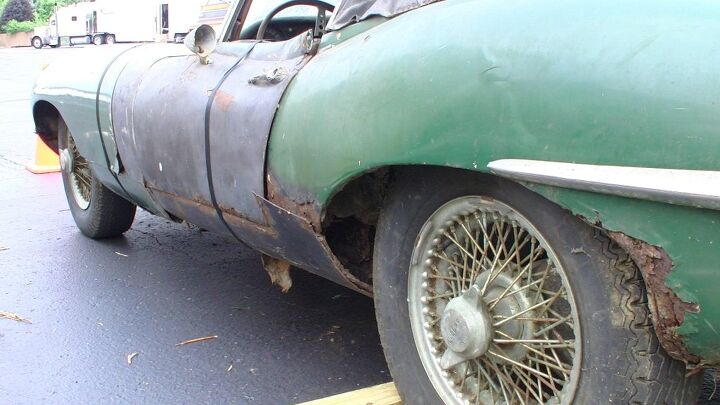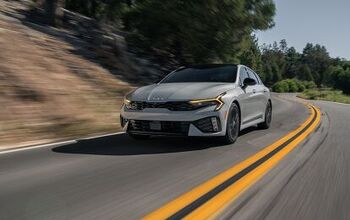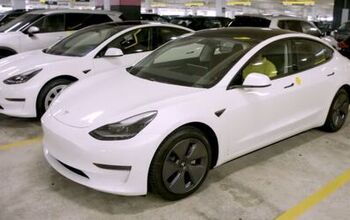Of Rust and Restoration: Is There Such a Thing As an Unrestorable E-Type Jaguar?

If you haven’t noticed, Series I Jaguar E-Types have gotten very pricey. There were only about 75,000 Es made and not all have survived for a half century. The E-Type had one of the early monocoque unibodies and it was almost as if it was designed to trap water and rust. Also, quite a few were roadsters and open cars don’t do well when exposed to the elements. That’s made all E-Types rare enough to become valuable (well, that and things like a supple suspension, the outstanding Jaguar XK DOHC inline-six, and a body that even Enzo said was sexier than his Ferraris).
They’re so valuable that at this point it may well be that there is no such thing as an unrestorable example. A number of restoration shops around the world specialize in bringing back E-Types. Every body component is available, and it’s no exaggeration to say that as long as there is a number plate, they can probably rebuild an E around it. There’s even a chance, what with the E’s insane appreciation, that you might not even be underwater after the restoration is done.
I thought about that when I saw this heavily patinated ’64 E-Type coupe for sale on eBay for $47,000.
This particular E Type actually appears worse than it really is. A barn find with minimal rust and an operational drivetrain makes it a great candidate for a restore or preserve debate.
There are far, far worse Jaguars that get restored.
Don’t believe me? I give you Exhibit E:
Like the E-Type on eBay, it’s a Series I Car, though it’s a roadster in a shade of British Racing Green. Unlike the car on the auction block, which could be a driver with just a little work, this one is literally falling apart.
The doors are held on by a ratcheted web strap, as is the front clamshell hood — which itself appears to be held together by a large bungee cord. The floors are but a memory and the sills and rocker panels, important structural elements of the Jaguar’s unibody, can be seen through, end to end. There is a big crack in one of the doors’ sheet metal. I don’t know about the engine, but the transmission is still there, I suspect held up by the same strap holding the doors on. The prized glass headlamp covers that distinguish early E-Types are long gone, as are the headlamps and buckets themselves, along with the taillamps. Inside, most of what upholstery that remains is rotted, though some is surprisingly intact. Also intact, but in need of serious restoration, are all four wire spoke knock-off wheels. It still has a roof, but either the side glass is missing or the windows are stuck in their down positions, so the interior has been exposed to Michigan’s rain and snow.
From the license plates, it appears to have last been registered in 1973.
Ironically, this particular car was found at the site of the Concours of America at St. John’s. No, it wasn’t in the show, though it would make for an interesting display, as they’ve had barn finds before. I spotted it on the far edge of the parking lot used for loading by the exhibitors, where the trailer queens’ trailers were parked.
At first I didn’t understand what it was doing there. It certainly wasn’t there for the show and there wasn’t a For Sale sign on it. Parked nearby was a vintage GMC Motorhome that, coincidentally, I’d earlier seen on display at one of Greenfield Village’s car shows (where I chatted with the owners). They happened to be hanging out in their GMC and we renewed our acquaintance, but they had no idea about the trashed E-Type.
As I left the St. John’s facility after the show ended, parked at the side of Plymouth Road were the tractor trailers from Reliable Carriers, Horseless Carriage, and other transportation companies that specialize in moving collectible cars. Vehicles from the concours were being loaded onto the trucks, with some jockeying being done to get them loaded in the correct sequence. That’s when I realized what the basket case Jaguar was doing at a concours d’elegance.
I’m not very adept at fiction, so I can’t spin a yarn about how the tired Jag ended up sitting forlornly, a wallflower at the side of the dance, but I can hazard a guess what it was doing there, practically in the shadow of seven figure blue ribbon winners. That Jaguar was going to be restored, and it likely had already been sold by its Michigan owner and was on its way to a new owner (or a restoration shop chosen by that owner). It was probably offloaded from one of the car carriers’ trailers to allow them to also unload show cars. Perhaps the previous owner had a car or cars in the concours and, when the carrier picked up the show cars from the owner, they also picked up the Jaguar to be shipped to its new owner.
However it ended up there, it raises the question, just how far gone does a Jaguar E-Type have to be to be considered unrestorable?
[Images: eBay, Ronnie Schreiber/TTAC]

Ronnie Schreiber edits Cars In Depth, the original 3D car site.
More by Ronnie Schreiber
Latest Car Reviews
Read moreLatest Product Reviews
Read moreRecent Comments
- AZFelix What could possibly go wrong with putting your life in the robotic hands of precision crafted and expertly programmed machinery?
- Orange260z I'm facing the "tire aging out" issue as well - the Conti ECS on my 911 have 2017 date codes but have lots (likely >70%) tread remaining. The tires have spent quite little time in the sun, as the car has become a garage queen and has likely had ~10K kms put on in the last 5 years. I did notice that they were getting harder last year, as the car pushes more in corners and the back end breaks loose under heavy acceleration. I'll have to do a careful inspection for cracks when I get the car out for the summer in the coming weeks.
- VoGhost Interesting comments. Back in reality, AV is already here, and the experience to date has been that AV is far safer than most drivers. But I guess your "news" didn't tell you that, for some reason.
- Doc423 Come try to take it, Pal. Environmental Whacko.
- 28-Cars-Later Mazda despite attractive styling has resale issues - 'Yota is always the answer.

































































Comments
Join the conversation
Years ago my mechanic/body man had a 62 coupe one of these sitting in his parking lot which the owner dropped off for restoration. It sat there when he closed his shop and moved. It was in worse shape than this one. I always wonder what happened to it. I would have to say I have always loved this model and think it too is one of the most beautiful cars I have ever seen which I cannot say about any of today's cars.
I recently read a book called "Warbirds" - about finding crashed or abandoned planes from WW2, and restoring them. We're talking hulks that have taken battle damage, crashed into trees/mountains/swamps, or even frozen or lost in a lake. The accessible ones were often stripped of parts by the locals, but the more remote ones were found untouched with still-working machine guns. The planes would be cut up and often moved with the wings removed. Major restoration work done to get them flying again; almost to the point where I wonder how much is "original" and how much is new fabrication. At what point does a restoration become something new? /philosophical question